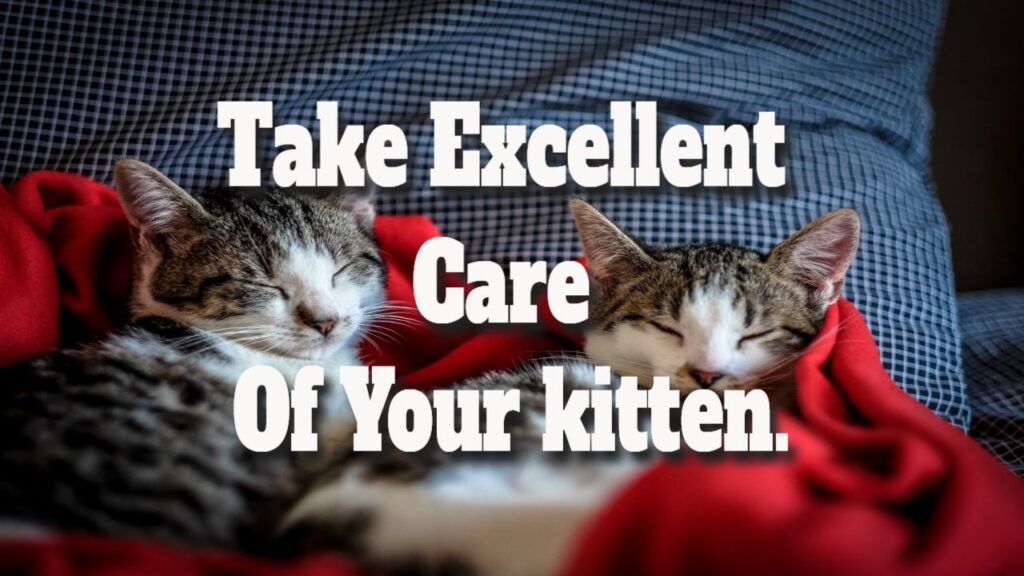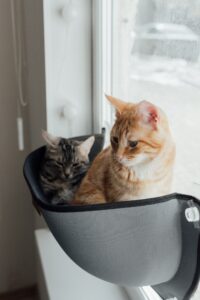Your cart is currently empty!
Take Excellent Care Of Your Kitten

Take Excellent Care Of Your Kitten.
Bring in your new kitty.
Take Excellent Care Of Your kitten.: To begin, make sure that all windows and doors leading to the outside are closed and that any nooks and crannies are covered up to avoid potential risks. Kittens are very inquisitive, and they might become bewildered or stuck in the most inaccessible places. You should keep an eye on them for as long as possible because they are still in the acclimatisation phase.
Kittens are naturally hygienic and avoid keeping their litter box near their food and water dishes. Cats prefer to drink in a different location than where they eat, therefore keep the water bowl near the food bowl.
Give them a small, comfortable bed (but don’t be surprised if they choose where they sleep!) During the first few nights, a warm (not hot) water bottle under a blanket can help fill the vacuum left by the absence of a mother or siblings.
To a little kitten, the world can appear huge. For the first few days, limit it to a single room so it may become acquainted with where it feeds, sleeps, and relieves itself.
A litter box is essential for housetraining because if the cat is accustomed to using it, it will seek it out when it is free to roam the house.
The kitty will be introduced to little children and other pets.
To ensure a smooth transition, proceed with caution while introducing your kitten to other family members and pets.
Children
Young children can be pleased when a new pet enters their family. As a result, there’s a good chance they’ll overpower a new kitten.
Make it clear that this is not a toy that children can play with all day. Overbearing children should be diverted to other activities so that your cat can gradually acclimate to the new environment and family members.
Teach children to wait until the cat approaches before playing, and keep play sessions short. Kittens have an instinctive desire to play with their claws and fangs. As a result, encouraging your children to focus on appropriate toys as early as possible will pay dividends later in life.
Your kitten’s socialisation
Socialization is critical for your cat to develop the skills necessary to become a well-rounded and happy individual capable of dealing with the challenges that may arise later in life.
Cats learn a lot during their first two months of life, and this shapes their worldview.
They will be wary of everything they haven’t learnt about in this short period of time in the future. Begin by making a list of everything that needs to be considered. This includes all the child is capable of perceiving.
Kittens must learn to touch, stroke, and bond with people because these abilities do not come easily to them.
When kittens are properly introduced, they learn to value direct human touch with their owners, although most adult cats do not!
Give your cat something to eat.
Determine what your cat has been eating and feed it to her when you get home. An abrupt change in cuisine, along with the stress of moving, may cause stomach distress and diarrhoea.
After your kitty has habituated to the new food for a few days, you can gradually introduce it to him. Kittens have small stomachs and must be fed on a regular basis.
The simplest way to give a growing kitten a nutritious diet is to provide a ration of a high-quality complete food. Typically, this is dry food, though some firms offer canned food as well.
These diets are designed specifically for kittens, who have different nutritional needs than adult cats. All feeding instructions should be carefully read and followed.
When you feed the kittens, they have free access to dry food (unless other animals eat the kittens’ food).
Because canned food spoils quickly in the bowl, it must be eaten in several meals throughout the day. Kittens between the ages of eight and twelve weeks require four meals per day, kittens between the ages of three and six months require three meals, and kittens older than six months require two meals per day.
Keep milk away from cats as it can cause diarrhoea. Kittens, like all other animals, require constant access to clean drinking water.
Toilet training for your kitten
Cats are very clean creatures that, with the correct encouragement, will quickly become housebroken. Kittens learn to use the litter box from their mothers, but they may want our assistance as well.
Following a meal, your cat may want to use the restroom, wake up from a slumber, smell the floor, scratch or crawl, and generally look to need to use the restroom right away!
If your cat urinates in other areas of the house, you may want to confine him to a litter box area until he learns to use it on a regular basis.
You’ll need a plastic litter box large enough to accommodate cat litter. These are available at any pet store and grocery. Garden soil should not be used because it can infect other cats.
The litter box should be put on newspaper to catch litter thrown over the edge while digging. The box, however, should not be too deep for your kitty to climb inside. For the first few weeks of your kitten’s life in the garden, an open litter box will suffice.
If you want the cat to continue using the bowl, purchase a covered bowl to provide extra privacy, keep odours out, and prevent messes.
Place the bowl in a quiet, easy-to-access location where your cat will not be bothered. Keeping the kitten’s food and water bowls, as well as the litter box, separate, is always a smart idea, since the kitten may be hesitant to use a litter box close to the food.
Keep the litter box clean at all times. Instead of emptying the litter box completely every day, remove only the soiled litter to encourage the cat to return because it smells “familiar.” Unless your cat is suffering from diarrhoea or the litter box is really dirty, you should only empty it once a week (in which case you should clean it much more frequently). Some disinfectants that become cloudy in water (for example, Dettol) are hazardous to cats. As a result, use hot water and a few dishwashing solutions to clean the litter box.
A cat who refuses to use the litter box could be an issue. All of the following are potential perpetrators:
It’s filthy; in this case, you should clean it more often.
It’s too little; an adult cat should be able to whirl around in it and use it several times before it gets muddy.
You used a chemical with a strong odour to clean it.
The kitty’s bed and feeding bowls are in the way.
If your cat does not like the litter you selected for him, try a different brand or return to an old favourite.
If your cat starts going outside more regularly, move the litter box closer to the door. A few handfuls of litter from the litter box thrown over freshly excavated garden soil may tempt your kitty to dig there.
Only when your kitten has begun using the garden should you remove the litter box from the house.
When should you let your kitten outside?
Keep your kitten in a confined location for at least one week after its initial immunisation (at 13 to 14 weeks of age, depending on the vaccine).
Take your kitten outside on a dry day and during a quiet time to explore his new surroundings. Accompany your kitty until she is at ease in the garden, then return her to the home quickly.
Even if your kitten was spayed or neutered before you got here, don’t let her go outside alone until she’s at least five months old.
Cats prefer to come and go as they want, and the best way for them to do so is through a cat flap.
You may educate your kitten to use the cat flap by sliding it open first and luring him through with appetising food. Slowly close it so the kitten learns to push the flap to get through.
If you already have a cat who utilises the flap, consider that the kitten may be observing it and learning to open it before you do. Kittens quickly pick up new skills by studying other cats.
You can keep other cats out of your house by attaching a magnetic or electric key to your cat’s collar and activating a unique cat flap.
Your cat should be microchipped and identified.
Cats above the age of six months who can go outside on their own should be allowed out more frequently, and you should wear an identifying collar and possibly carry a magnet or key for an electronic cat flap.
Collars must be used correctly since kittens are very active and curious when they are young. Injuries can occur if the kitten’s front limb becomes entangled in the collar or if the collar becomes entangled in a branch or fence.
The most secure solution for all cats is quick-release collars that open when a cat gets hooked somewhere. Check the collar on young, fast-growing cats periodically (you should be able to slide a finger or two under the collar) and adjust the collar size accordingly.
Microchipping your kitty is a good idea. Microchips are implanted under the skin between the shoulder blades to provide long-term identification.
A “bar code” incorporated in the chip can be scanned with a scanner. In the event that your kitten is stolen, the code number and personal information will be kept in a national database. Your veterinarian can explain microchipping to you.
Unforeseen hazards
Kittens are inquisitive, and they will investigate any small, dark space they can burrow into. Whether your kitten has been gone for an extended period of time, check closets, cabinets, sheds, and other spaces to determine if she has become trapped or lodged.
Keep the washer and dryer doors closed when not in use, and inspect them before putting clothing in them. Remove any possibly hazardous plants, for example.
Dieffenbachia sp (yarrow).
Poinsettia
The Lilly of the Valley is a type of flower that grows in the United States.
The castor bean plant
The rubber tree
Ivy
Cats tend to avoid such plants, but kittens may be more interested. Keep windows secured or invest in fly screens if you live in a mezzanine or multi-story home to prevent kittens from escaping.
Garden chemicals should be handled with care, and slug baits and chemicals in the garden should be used carefully because some can be dangerous to animals.
The post Take Excellent Care Of Your Kitten appeared first on https://gqcentral.co.uk
